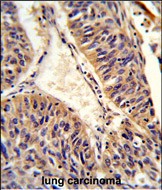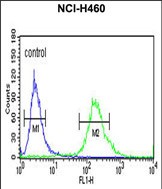ALG14 Antibody (Center)
Affinity Purified Rabbit Polyclonal Antibody (Pab)
- SPECIFICATION
- CITATIONS: 1
- PROTOCOLS
- BACKGROUND

Application
| WB, FC, IHC-P, E |
|---|---|
| Primary Accession | Q96F25 |
| Reactivity | Human |
| Host | Rabbit |
| Clonality | Polyclonal |
| Isotype | Rabbit IgG |
| Calculated MW | 24151 Da |
| Antigen Region | 67-93 aa |
| Gene ID | 199857 |
|---|---|
| Other Names | UDP-N-acetylglucosamine transferase subunit ALG14 homolog, ALG14 |
| Target/Specificity | This ALG14 antibody is generated from rabbits immunized with a KLH conjugated synthetic peptide between 67-93 amino acids from the Central region of human ALG14. |
| Dilution | WB~~1:1000 FC~~1:10~50 IHC-P~~1:50~100 E~~Use at an assay dependent concentration. |
| Format | Purified polyclonal antibody supplied in PBS with 0.09% (W/V) sodium azide. This antibody is purified through a protein A column, followed by peptide affinity purification. |
| Storage | Maintain refrigerated at 2-8°C for up to 2 weeks. For long term storage store at -20°C in small aliquots to prevent freeze-thaw cycles. |
| Precautions | ALG14 Antibody (Center) is for research use only and not for use in diagnostic or therapeutic procedures. |
| Name | ALG14 (HGNC:28287) |
|---|---|
| Function | Part of the UDP-N-acetylglucosamine transferase complex that operates in the biosynthetic pathway of dolichol-linked oligosaccharides, the glycan precursors employed in protein asparagine (N)-glycosylation. The assembly of dolichol-linked oligosaccharides begins on the cytosolic side of the endoplasmic reticulum membrane and finishes in its lumen. The sequential addition of sugars to dolichol pyrophosphate produces dolichol-linked oligosaccharides containing fourteen sugars, including two GlcNAcs, nine mannoses and three glucoses. Once assembled, the oligosaccharides are transferred from the lipid to nascent proteins by oligosaccharyltransferases. Functions as a protein-membrane adapter recruiting ALG13 at the cytoplasmic face of the endoplasmic reticulum, where the complex catalyzes the second step of dolichol pyrophosphate biosynthesis, transferring a beta1,4-linked N-acetylglucosamine (GlcNAc) from UDP-GlcNAc to GlcNAc- pyrophosphatedolichol (Gn-PDol) to produce N,N'-diacetylchitobiosyl diphosphodolichol. N,N'-diacetylchitobiosyl diphosphodolichol is a substrate for ALG1, the following enzyme in the biosynthetic pathway. |
| Cellular Location | Endoplasmic reticulum membrane; Single-pass membrane protein |

Provided below are standard protocols that you may find useful for product applications.
Background
ALG14 is involved in protein N-glycosylation. It is essential for the second step of the dolichol-linked oligosaccharide pathway. It anchors the catalytic subunit ALG13 to the ER.
References
Gao X.-D., et.al., J. Biol. Chem. 280:36254-36262(2005).
If you have used an Abcepta product and would like to share how it has performed, please click on the "Submit Review" button and provide the requested information. Our staff will examine and post your review and contact you if needed.
If you have any additional inquiries please email technical services at tech@abcepta.com.














 Foundational characteristics of cancer include proliferation, angiogenesis, migration, evasion of apoptosis, and cellular immortality. Find key markers for these cellular processes and antibodies to detect them.
Foundational characteristics of cancer include proliferation, angiogenesis, migration, evasion of apoptosis, and cellular immortality. Find key markers for these cellular processes and antibodies to detect them. The SUMOplot™ Analysis Program predicts and scores sumoylation sites in your protein. SUMOylation is a post-translational modification involved in various cellular processes, such as nuclear-cytosolic transport, transcriptional regulation, apoptosis, protein stability, response to stress, and progression through the cell cycle.
The SUMOplot™ Analysis Program predicts and scores sumoylation sites in your protein. SUMOylation is a post-translational modification involved in various cellular processes, such as nuclear-cytosolic transport, transcriptional regulation, apoptosis, protein stability, response to stress, and progression through the cell cycle. The Autophagy Receptor Motif Plotter predicts and scores autophagy receptor binding sites in your protein. Identifying proteins connected to this pathway is critical to understanding the role of autophagy in physiological as well as pathological processes such as development, differentiation, neurodegenerative diseases, stress, infection, and cancer.
The Autophagy Receptor Motif Plotter predicts and scores autophagy receptor binding sites in your protein. Identifying proteins connected to this pathway is critical to understanding the role of autophagy in physiological as well as pathological processes such as development, differentiation, neurodegenerative diseases, stress, infection, and cancer.



